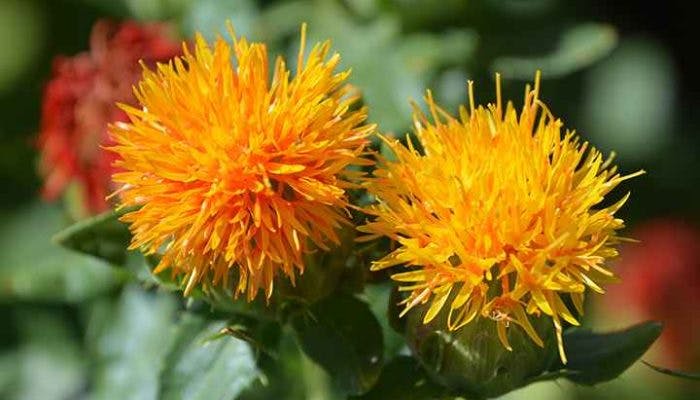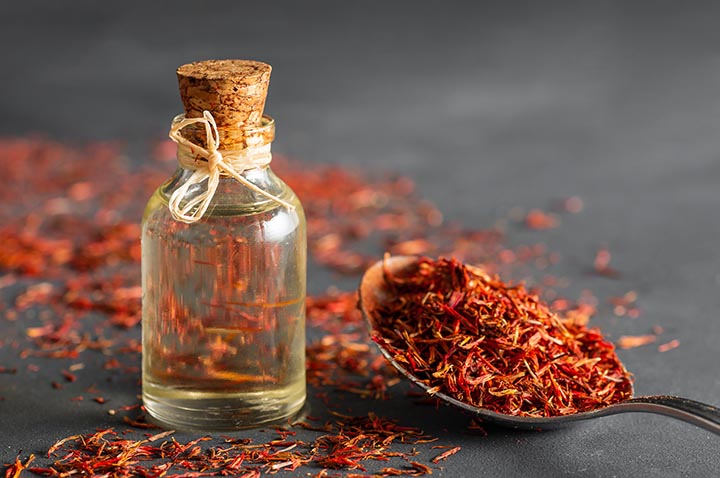Safflower

What is Safflower?
Safflower (hong hua, 红花) is a flowering plant with long, tubular stems and flowers that are orange, red or yellow in appearance. In the past, the Safflower was commonly cultivated as a dye plant, making it a key component in red and yellow dyes that were applied to ancient Egyptian textiles. Also, Safflower garlands were reportedly discovered in the Pharaoh Tutankhamen’s tomb, and mummies were often wrapped in linens that were dyed with Safflower.
In 1551, Safflower was brought to Europe from Egypt. In 16th century England, legal documents were tied together with red tape to discourage them being tampered with, and Safflower was the ingredient used to dye those bindings red.
Safflowers are plucked from the plant in the Summer after the petals turn bright red, and are later dried in the shade for medicinal usage.
In Traditional Chinese Medicine (TCM), Safflower falls under the category of ‘Herbs that invigorate the blood’. This herb can stimulate blood flow and treat Blood Stagnation. Warm in nature, Safflower can help people who have too much Cold in their body, such as those experiencing a Yin Excess or a Yang Deficiency, to restore a harmonious yin-yang balance.
Pungent in taste, Safflower can promote the circulations of qi and body fluids. In particular, the herb targets the Heart and the Liver.
Functions and Benefits of Safflower
According to TCM, it is believed that Safflower has the following health benefits:
Safflower can activate blood and dredge meridians to dispel Blood Stasis and alleviate pain. This herb is commonly used to treat Blood Stasis in gynecology and obstetrics. For example, it can address dysmenorrhea, postpartum abdominal pain, amenorrhea caused by Stagnant Blood, and to promote menstruation.
Safflower can dispel mass, unblock blood vessels and resolve swelling too. Hence, the herb can address symptoms such as abdominal masses, obstruction of heart vessels and angina pectoris, traumatic injuries, congestion, sores, abscess, swelling and pain. Safflower can also help to relieve numbness in hands, joint pain or paralysis.
When combined with Heat-clearing and toxicity-relieving herbs, Safflower’s properties in cooling blood and resolving Stasis is further reinforced, which makes it a great herb for dark macule and heat depression.
Modern studies have discovered many Safflower benefits for skin. Safflower can help to soften and lubricate the skin. By reducing moisture loss and providing linolenic acid, an ingredient necessary for the production of ceramides, the herb can strengthen the skin barrier and improve water retention in the skin. This makes Safflower a great herb for individuals suffering from eczema as the regular use of Safflower oil can increase ceramide levels in the skin to prevent water loss.
Many also use Safflower oil for acne. This is because it can cleanse bacteria, dirt and impurities from the skin by breaking down dead skin cells and excess sebum. The herb’s anti-inflammatory properties help to calm and heal the skin as well. Hence, it can help to heal spots, pimples and scars.
In addition, Safflower Oil can nourish and penetrate hair follicles while protecting them from free radical damage. This strengthens the hair follicles to encourage strong and healthy hair growth, eliminate dandruff and provide relief to a dry, itchy scalp. The herb also provides intense hydration to prevent protein loss in hair.

How to Use Safflower
The usual dosage of Safflower is 3 – 10g, depending on the exact condition being treated. Some healthcare practitioners also recommend Safflower Oil in much smaller doses, typically less than 1g.
Whole or cut dried Safflower petals can be found in many herbal shops and Asian markets. Safflower is also often available in the forms of powder or concentrated Safflower extract. Safflower Oil is also used for many occasions, such as for an aromatherapy massage or bath, moisturizer, or homemade skin and hair preparations.
Safflower is also often used in tea infusions to facilitate the expulsion of phlegm and to soothe symptoms of fever and jaundice.
Cautions and Side Effects of Safflower
Safflower should not be used by pregnant ladies and individuals experiencing bleeding disorders, such as those experiencing menorrhagia or peptic ulcer. Also, Safflower may prolong the coagulation time for blood, so it should be used with caution for individuals on blood thinners. In addition, overconsuming this herb may lead to side effects such as continuous bleeding.
Patients who are consuming anticoagulants such as heparin, warfarin, enoxaparin, or antiplatelet drugs such as aspirin, dipyridamole and clopidogrel, should also avoid consuming Safflower for the time being.
We strongly advise you to consult your healthcare provider before deciding to add Safflower to your healthcare routine. Also, if you are applying Safflower to your skin, it is best to do a skin patch test beforehand to prevent undesirable skin reactions.
Summary
Here is a summary for Safflower:
- Herb name (Chinese): 红花
- Herb name (Pin Yin): hóng huā
- Herb name (English): Safflower
- Herb name (Botanical): Flos Carthami
- Origin of species: Carthamus tinctorius L.
- Part(s) of herb used: Flower
- Geo-specific habitat(s): Henan, Hubei, Sichuan, Yunnan, Zhejiang
- Taste(s) & Properties: Pungent; Warm; Administrates the Heart and Liver Meridians
- Actions: Helps to improve blood circulation in the body; Eases pain caused by menstrual discomforts, childbirth and physical injuries; Removes Blood Stasis and relieves symptoms of skin haemorrhages or abdominal mass
References
Mani, V., Lee, S. K., Yeo, Y., & Hahn, B. S. (2020). A metabolic perspective and opportunities in pharmacologically important safflower. Metabolites, 10(6), 253.[Accessed on 15th November 2022]
Yao, D., Wang, Z., Miao, L., & Wang, L. (2016). Effects of extracts and isolated compounds from safflower on some index of promoting blood circulation and regulating menstruation. Journal of ethnopharmacology, 191, 264-272.[Accessed on 15th November 2022]
Zhou, X., Tang, L., Xu, Y., Zhou, G., & Wang, Z. (2014). Towards a better understanding of medicinal uses of Carthamus tinctorius L. in traditional Chinese medicine: a phytochemical and pharmacological review. Journal of ethnopharmacology, 151(1), 27-43. [Accessed on 15th November 2022]
Share this article on
